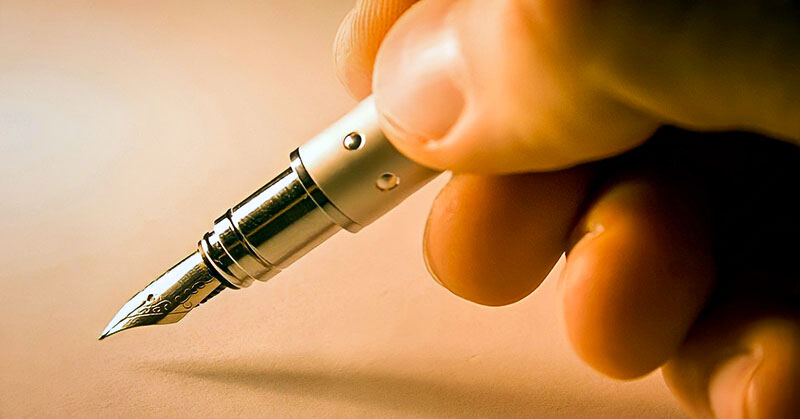Writing a forgiveness letter can be an incredibly cathartic part of your healing journey.
It’s an opportunity for you to exorcise all manner of hurts, giving you a safe space to express all your feelings without worry about judgement or recrimination.
Chances are, at some point, you’ve experienced a situation that made you feel powerless, or hurt you deeply, or made you feel that you were unable to express your feelings.
This could have been because you weren’t in a safe enough space to be able to tell that person how you really felt, or you might have never had the opportunity to do so, such as after being abandoned or ghosted.
Whether you’re dealing with unexpressed emotions that keep churning in your belly, or PTSD that haunts you regularly, a forgiveness letter can benefit you in many different ways.
Read on to learn how to write one, and how the physical act of releasing your thoughts and emotions onto paper can be immensely healing.
What Is A Forgiveness Letter, Exactly?
In simplest terms, it’s a letter that you write to a person who has hurt you.
With this letter, you have the opportunity to pour out all your thoughts and feelings about everything that transpired between you; about how their actions affected you, and how you feel about them.
It’s important to remember that traumatic experiences don’t heal quickly. In fact, they can create lasting hurts that can echo long after the incident occurred.
This is especially true if we never had the chance to get closure, such as if a partner hurt us deeply and then ghosted us, or if we’ve been assaulted by a stranger whom we never had a chance to confront.
That person never got to know about the damage they caused, and you might have never had the chance to release all the thoughts and emotions you felt about the incident.
That damage can fester if it isn’t expressed, and manifest in countless different ways: physically, emotionally, and spiritually. For example, in Traditional Chinese Medicine (TCM), it’s believed that kidney stones are caused by unexpressed rage.
Sure, you might never have the chance to tell the jerk who hurt you how you feel about them face to face – they might never find out at all – but a forgiveness letter is the next best thing.
In your own time, on your own terms, you write down everything you ever wanted to say to this person.
You can phrase things however you like, from heartfelt outpourings to frothing fury.
Everything you feel is okay.
Everything you feel is valid.
Write it all down, get it out.
By doing so, you’re setting all that held-in hurt, frustration, and anger free, so the person who hurt you will no longer live rent-free in your mind, body, or soul.
How Does It Help You Heal?
A forgiveness letter allows you to take control over a situation that might have made you feel helpless.
You take all the emotions you felt because of this and make them tangible, physical, with pen and paper.
This very act is incredibly empowering, as it gives you your sovereignty back, while also helping you to release hurts that might have been roiling within you for years.
One of the most important things to remember when it comes to radical forgiveness is that it really isn’t about the other person – it’s about you.
Lutheran pastor Nadia Bolz-Weber gave a spectacular-yet-brief interview entitled “Forgive Assholes“.
In it, she describes how when people do us harm, we end up being attached to that mistreatment like a sort of chain.
That holding onto the pain they’ve caused just ends up hurting us in the long run.
Kind of like holding onto a burning coal: we’ll start to heal as soon as we let go of it.
But if we don’t, rather than healing from what our enemy did to us, we may end up becoming like them because of our pain and bitterness.
Bolz-Weber reinforces the idea that forgiving people who hurt us doesn’t make us weak, or doormats, but is rather more “badass” than that.
By forgiving the jerk, we step free from the victim mindset and wield a set of spiritual bolt-cutters, thus choosing to sever that chain that still binds us to them.
We empower ourselves, and take action to free ourselves from them forever.
Basically, our actions say: “What you did was so not okay that I refuse to be connected to it anymore”.
That’s what this forgiveness letter can do for you.
How To Go About Writing One
There is no one “right” way to go about writing your forgiveness letter: it’s all a matter of individual preference.
Some people like to bring themselves back to the time when they were hurt, so all their emotions are fresh and raw when they spill them out onto paper.
If this is something that works well for you, that helps you get old pain out, then go for it!
Just keep some tissues handy.
Others prefer calm and peace, choosing to focus on the kind of catharsis they want to achieve with this action.
They’ll set aside a block of time when they won’t be interrupted, put on gentle music that inspires them, light some candles or incense, and set all their intentions toward forgiveness and release.
As mentioned earlier, it’s important to remember that this forgiveness isn’t about absolving the other person (or people) of all the horrible things they did to you.
It’s about severing any remaining threads that keep them bound to you so you can leave them in your past and never look back.
However you choose to approach yours, whether it’s with crayon scrawlings or fountain pen, on fine stationery or scrap paper, is absolutely fine.
It’s all about intention.
Just make sure that it’s an actual physical letter, rather than an email that you’ll delete.
If you have difficulty with motor dexterity and it’s easier for you to type things out than write them by hand, no problem: print it out once you’re done so you can hold it in your hands, and dispose of it physically.
The very act of transferring your internal turmoil into a physical object is the magic, here.
Merely clicking “delete” on an email doesn’t have the OOMPH power needed to make real change happen.
What To Do With Your Forgiveness Letter
Since the entire focus of this endeavor is the concept of letting go, the best thing to do with your forgiveness letter is to dispose of it.
Keep in mind that you’re pouring a lot of pent-up emotion into this physical object, so it’s best not to keep it in your home once you’re done.
If you do, you’ll know subconsciously that it’s still around, and its presence can permeate your mind and spirit.
You may not be immediately aware that it’s letting off all kinds of negative energy, but if it’s still around, then so are your feelings about the person you’ve written to.
Gotta let that stuff go.
For many people – myself included – burning these letters is one of the most cathartic rituals imaginable.
Write the recipient’s name onto an envelope (three times if you really want to get magical with it), and seal the letter into it. Some people even like to tie string around the envelope as well, to symbolize an even stronger binding or fastening.
You don’t have to burn the letter if you feel uncomfortable about doing so, or if setting something on fire could be hazardous in your area.
Instead, you can bury it outside, throw it away, or dissolve it in a bucket of water. The key aspect is destruction of some kind.
If you do choose to set the letter alight, please do so in a safe manner that won’t set you, your home, surroundings, or the natural world ablaze.
Watch the paper as it burns, and envision every thought and emotion that still binds you to that person drifting away along with the smoke.
It won’t take long for the letter to be reduced to nothing, and as it does so, you can practically feel all those old hurts crumble into ash along with it.
Once that ash has cooled completely and there’s no risk of sparks, you can blow the ash into the wind, scatter it outside, or even flush it. Your call.
Remember That This Is For You, Not The One Who Hurt You
Some people feel tempted to send letters like this to the person/people who hurt them, in the hope of empowering themselves by having the last word.
This never goes well, especially if you’re dealing with a narcissist, sociopath, or someone with borderline personality disorder.
Sure, you might feel a temporary sense of happiness and closure because you’re the one who took action… but that other person may feel like one-upmanship is in order, and will retaliate with a “f**k-you” letter of their own.
…which will just end up hurting you again, which will require another forgiveness letter for your own empowerment and self-healing, etc.
It’s an ugly cycle that you really don’t want to get trapped in.
This letter is all about you: re-establishing your personal power, healing old wounds, and using your voice to express everything you need to.
The last thing you want to do is open doors for the one(s) who hurt you to be able to do so again.
Make your self-healing, self-empowerment, and self-care a priority, here.
Even if you really want the letter’s recipient to be happy and fulfilled in their life as part of your healing process, just set the intention mentally and spiritually.
Put that all in the letter, and as it burns, imagine the smoke wafting over to wherever they are and granting them peace.
But this is for you, not them.
Whether you’re wishing them well, or screaming at them on paper, let this act of forgiveness sever all cords and close all doors to them forever.
Those people, and all the hurt they caused you, are in the past.
And you don’t live there anymore.
You may also like:
- How To Forgive Someone: 2 Science-Based Models Of Forgiveness
- How To Forgive Yourself: 17 No Nonsense Tips!
- How To Let Go Of Anger: The 7 Stages From Rage To Release
- How To Let Go Of The Past: 16 No Nonsense Tips!
- The 6 Key Things You Can Do To Find Inner Peace











